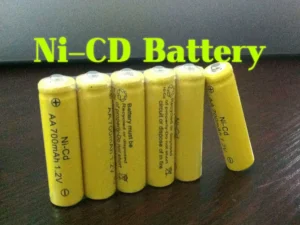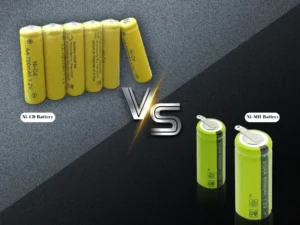Introduction:
Nowadays, rechargeable batteries are rapidly becoming popular, and most devices use them. What is the difference between Ni-Cd and Ni-MH rechargeable batteries? Many people may wonder about this.
These are the two most popular choices for the battery. Devices such as digital cameras, portable computers, drills, camcorders, and other devices use this. Both serve the same function, and the difference is in the performance and effect on the environment. NiCd VS NiMH battery, what is the difference? Let’s move on to the next part of this article to learn more about this stuff.
What are NiCd batteries?

Before we get into the NiCd VS NiMH battery, we need to look at them separately and in-depth. Let’s start with NiCd batteries. Nickel-Cadmium batteries, popularly known as NiCad. It is the type of battery seen in toys, industrial products, commercial items, medical equipment, and some tools.
Batteries have been around for some time, but in 1899, Waldner Jungner of Sweden discovered them. That is the beginning of the journey of NiCad Batteries. A fully charged NiCd battery contains the following:
- Nickel Hydroxide positive electrode plate
- Cadmium negative electrode plate
- separator
- Potassium Hydroxide
The batteries have a metal case, a sealing plate, and a safety valve. Inside the case, the negative and positive electrode plates are secluded from each other using a separator. The components of the battery are rolling in a spiral shape case. This structure is the jelly-roll design. The jelly-roll design allows the Ni-Cd cell to produce a higher current than the equivalent-size alkaline cell. This configuration started only in the 2000s.
What are the advantages and disadvantages of NiCd batteries?
NiCd batteries are budget-friendly. When an item requires a high discharge rate for a low price, usually they use this battery. NiCd rechargeable batteries have been around for many years. To know more about it, here are the advantages and disadvantages of this battery.
Advantages
- High Energy Density
The NiCd batteries have a high discharge rate. That means it can store a lot of energy in a tiny space. That is one of the reasons why portable products that require powerful batteries use this.
- Long Vitality
The lifespan of NiCd is very long. It can recharge hundreds or thousands of times before replacement. That feature makes it a cost-effective material for devices that need it.
- Steadfast Performance
When it comes to performance, you can rely on NiCd. It has a foreseeable discharge curve that makes it stable throughout. Most outdoor devices and industrial products use this. That is because it can perform at extreme temperatures.
- Overcharging Tolerant
It’s a great safety feature. Overcharging is a common mistake on rechargeable devices. People mistakenly let devices charge longer than the required time. It can cause accidents if the battery is not tolerant to overcharging.
Disadvantages
- Charging Memory Effect
The battery life of the NiCd can reduce over time. Only partially discharging the battery before charging it can lead to it. It will affect the battery’s performance. One symptom of it is the battery can quickly get drained.
- Toxicity
NiCd batteries contain toxic compounds such as Cadmium. It is the Anode that contains metallic Cadmium. It can be very harmful to nature. Proper disposal is important for this. That is why some companies are reducing the use of this and converting it to eco-friendly batteries.
- Low Energy Efficiency
Compared to the latest batteries of this time, it has lower energy efficiency. It requires more charging time and can result in a higher energy cost in the long run.
What are NiMH batteries?

Let’s move on to the Nickel-Metal Hydride or NiMH battery. It is similar to NiCd because it uses nickel-based chemistry. However, this one does not contain harmful toxic Cadmium. Instead, they use a metal hydride as its negative electrode.
The work on the NiMH batteries began in 1967 at Battelle-Geneva Research Center. The interest in this grew in the 1970s, with Hydride Technology promising a new way to store hydrogen. In the 1980s, NiMH batteries were developed as an alternative to NiCd batteries.
To learn more about NiMH, it contains the following:
- Nickel hydroxide positive electrode plate
- Hydrogen ion negative electrode plate
- separator
- Alkaline electrolyte
Items like automotive batteries, cameras, and other low-cost devices use NiMH rechargeable batteries. Between the NiCd VS NiMH battery, NiMH can also compete with it. The usual NiMH battery voltage is 1.2 V.
What are the advantages and disadvantages of NiMH batteries?
NiMH is a popular type of rechargeable battery. It is a replacement for the NiCd. NiCd VS NiMH battery is a competition between two great batteries. There are some features where NiMH won. Of course, there are some shortcomings. Now let’s move on to the advantages and disadvantages of NiMH batteries.
Advantages
- Higher Energy Density
It can store energy in a bit of space. That is why most portable devices are moving to use this type of battery.
- Eco-Friendly
It is one of the best features of this battery. It is recyclable and can be disposed of safely and efficiently.
- No Memory Effect
Some batteries suffer from memory effects, but not this one. What’s the memory effect? It’s a process in which the battery needs to be completely discharged before charging. If not, its performance will be affected. It can lead to fast battery draining. So, NiMH batteries are safe in this problem.
- High Current Output
One of the reasons why digital devices use this is because of the high current output. This is the battery that is suitable for those machines.
- Availability
This type of battery is widely available and compatible with most devices that use AA and AAA batteries. It is a great alternative to switching to rechargeable ones.
Disadvantages
- Short Lifespan
The ugly side is that it has a short life. It loses its charge when stored for an extended period.
- Self-discharge
The reason for the short life is it self-discharges quickly. It loses up to 30% of its charge monthly when not in use. Stocking this battery is a challenging idea.
- Temperature Sensitive
It’s a sensitive batter. It does not work well in very high or shallow temperatures.
- Longer Charging Time
This charging period is longer than the other batteries. It can sometimes require a special charger to avoid overcharging and undercharging. The reason is that it generates more heat during charging.
This battery does not accept fast charging, which is the trend now on all rechargeable gadgets.
NiCd VS NiMH battery

The battle between the Ni-MH VS NiCd battery is endless. These are two different batteries. They have similarities when it comes to the purpose of their use. However, there is more to see, as they have many differences that must consider.
Let’s differentiate between these two.
- Chemistry
The compound in NiMH VS NiCd battery is different. One contains a toxic chemical, while the other does not. Metallic Cadmium is toxic, which the NiCd has. NiMH uses hydrogen-absorbing alloy. Overall, both serve as tremendous rechargeable batteries.
- Memory Effect
The memory effect between the NiCd VS NiMH battery is the opposite. This feature is about remembering the charge and discharge cycle. NiCd is more prone to memory effects than NiMH. This circumstance can lead to a susceptible memory effect.
- Capacity
The capacity between the NiCd VS NiMH battery is different. NiMH batteries can store more energy and last longer than NiCd.
- Self-Discharging
The difference between NiCd VS Ni-MH is obvious. NiMH batters have higher self-discharge compared to NiCd. This means its charge will lose quickly when not in use.
- Environment Effect
What is the difference between Ni-Cd and Ni-MH when it comes to this? NiMH is more eco-friendly compared to NiCd. NiCd contains a toxic chemical that harms our environment. That is why it is essential to dispose of NiCd properly. NiMH batteries are more eco-friendly.
What is the difference between Ni-MH and Ni-Cd?
NiCd VS NiMH battery has the same goal. They make our lives easier because they power up our portable devices. These two types of batteries are widely used in many devices. Here are some of the products that use it.
- Portable power tools
- Digital cameras
- Flashlights
- Two-way radios
- Remote control toys
- Emergency power supplies
- Portable audio players
They might have the same purpose, but they have huge differences. NiMH is less harmful. However, NiCd is more powerful. NiCd VS NiMH charging method is also different. NiMH battery might need a special charger because it can’t take fast charging. It releases more heat than the NiCd. NiCd is more tolerant of overheating. Although they are both rechargeable, they have their differences. One is less toxic, but one is much stronger. Their strengths and weaknesses compete with one another.
Conclusion:
The competition between the NiCd VS NiMH battery has been happening for so long. Right after, the NiMH batteries come out to compete and be an alternative to the NiCd. The difference between the two is essential. It’s great to know what we have in our house and lives.
Of course, these are only the two types of rechargeable batteries. We have much more to know, and who knows what’s coming next? For now, they did an excellent job giving portability on some devices.
